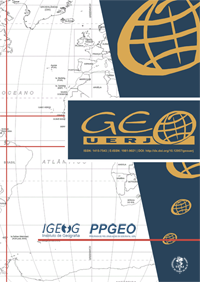INFLUÊNCIA DA RESOLUÇÃO DO MODELO DIGITAL DE ELEVAÇÃO NA DETERMINAÇÃO DO ÍNDICE TOPOGRÁFICO DE UMIDADE E NA CAPACIDADE DE PREDIÇÃO DOS TEORES CARBONO ORGÂNICO DO SOLO
DOI:
https://doi.org/10.12957/geouerj.2015.13452Palavras-chave:
Resolução, Atributos Topográficos, Áreas Úmidas, Carbono.Resumo
Doi: 10.12957/geouerj.2015.13452
Neste trabalho foram gerados Modelos Digitais de Elevação (MDE’s) utilizando dados altimétricos de duas fontes; carta topográfica na escala 1:50.000 e, levantamento altimétrico com um aparelho de posicionamento cinemático em tempo real (RTK) na escala 1:10.000. O objetivo foi investigar a dependência da escala na determinação do índice Topográfico de Umidade (ITU) para uma bacia hidrográfica do planalto do Rio Grande do Sul e, avaliar o potencial deste índice em discretizar os teores de Carbono Orgânico Total (COT) do solo. O efeito das diferentes resoluções sobre a distribuição espacial do ITU foi avaliada por meio de estatística descritiva. A análise entre os teores de carbono e estoque de carbono nos 57 pontos de amostragem de solo com os valores do índice topográfico de umidade foi feita por correlação linear. Os resultados obtidos comprovam que a utilização de MDE’s gerados com dados altimétricos de baixa resolução espacial são inadequados para discretizar às áreas com maior probabilidade de atingirem o estado de saturação hídrica, devido, principalmente, as limitações de acurácia posicional e vertical. A utilização de MDE’s gerados com dados altimétricos mais refinados, RTK, discretizou satisfatoriamente às áreas propensas à saturação hídrica. Os coeficientes de correlação entre o COT e estoque de carbono com os valores do ITU gerado com dados do RTK foram estatisticamente significativos, comprovando o grande potencial deste índice na predição dos teores de carbono nas cinco camadas de solo avaliadas e do estoque de C até 60 cm para a bacia hidrográfica estudada.
Downloads
Não há dados estatísticos.
Downloads
Publicado
2015-12-20
Como Citar
CAPOANE, Viviane; TIECHER, Tales; RASCHE ALVAREZ, Jimmy Walter Rasche; PELLEGRINI, André; SCHAEFER, Gilmar Luiz; SANTOS, Leonardo José Cordeiro; SANTOS, Danilo Rheinheimer dos. INFLUÊNCIA DA RESOLUÇÃO DO MODELO DIGITAL DE ELEVAÇÃO NA DETERMINAÇÃO DO ÍNDICE TOPOGRÁFICO DE UMIDADE E NA CAPACIDADE DE PREDIÇÃO DOS TEORES CARBONO ORGÂNICO DO SOLO. Geo UERJ, Rio de Janeiro, n. 27, p. 144–155, 2015. DOI: 10.12957/geouerj.2015.13452. Disponível em: https://www.e-publicacoes.uerj.br/geouerj/article/view/13452. Acesso em: 4 dez. 2025.
Edição
Seção
Artigos
Licença
Os Direitos Autorais dos artigos publicados na Revista Geo UERJ pertencem aos seus respectivos autores, com os direitos de primeira publicação cedidos à Revista. Toda vez que um artigo for citado, replicado em repositórios institucionais e/ou páginas pessoais ou profissionais, deve-se apresentar um link para o artigo disponível no site da Geo UERJ.

Os trabalhos publicados estão simultaneamente licenciados com uma Licença Commons BY-NC-SA 4.0.


